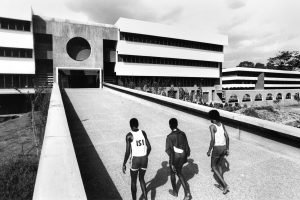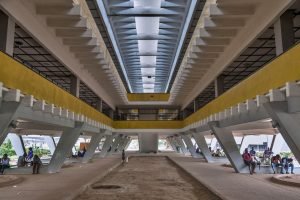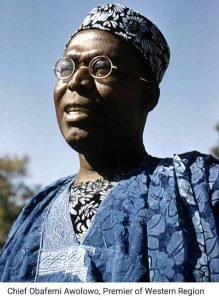
This material below is reproduced from The New York Times. It is reproduced for many reasons, one of which is that it solves a puzzle about which Intervention also has written about in its August 5th, 2018 piece “Obafemi Awolowo University, Ile-Ife As a Bundle of Questions” (reproduced below). Above all, this proves the thesis that Nigeria's founding fathers planned the initial universities to be world class institutions rather than what subsequently became the reality. The Obafemi Awolowo University section is an excerpt from the report which is a much longer stuff in tThe New York Times, ( April 18th, 2019). All pic credit to Andrew Esiebor/NYT
In April 1919, the architect Walter Gropius founded one of the most influential art and design schools ever: the Bauhaus. Students learned to focus on simplicity and functionality. Teachers favored primary colors and bold shapes. Seeing the school as a hotbed of utopian intellectualism, the Nazis forced its closure in 1933, scattering Bauhaus teachers, students and aesthetics across the globe.
The school changed everything from furniture to graphic design. But the Bauhaus’s biggest legacy is in architecture. Here’s where that legacy stands in Argentina, Nigeria, Israel, Australia, Iraq, the United States and India.
Design led by Arieh Sharon, built over 18 years beginning in the early 1960s.
Arieh Sharon, an Israeli architect, only studied at the Bauhaus by accident. In 1926, while in Germany, he saw a magazine article about it and on a whim booked a train ticket to Dessau, the east German city where the school was then based.
Five years later, he returned to what was then Palestine, and the simple whitewashed buildings he designed there helped give the expanding city of Tel Aviv a global architectural reputation.
By 1948, he was the head of Israel’s National Planning Authority, but the “decisive challenge” in his life, as he wrote, occurred in 1960 some 4,000 miles away in Nigeria, when he was commissioned by a local government and an Israeli firm to build a new university in the city of Ife.


The government’s vision was for a campus that showed Nigeria could move on from British rule. Sharon ensured it was a project for its location, not a thoughtless building dropped into the landscape, said Cordelia Osasona, a professor of architecture history at the university. Several buildings are shaped like upside-down pyramids, so the lower floors are shaded from the sun and rain. He made sure the natural air-flow is always maximized, keeping people in the buildings cool.
He also tapped into mythology of the Yoruba, the ethnic group that dominates this part of Nigeria. An obelisk on campus echoes the Oranmiyan Staff, a tall stone monument with metal studs in Ile-Ife city, which commemorates the death of a legendary Yoruba king.
Cordelia Osasona, professor of architecture history:
“We pride ourselves on having Africa’s most beautiful campus. Our school anthem even refers to it: ‘Great Ife, Great Ife, Africa’s most beautiful campus.’”
“[Sharon] wasn’t replicating the Bauhaus. Rather, he tropicalized and contextualized it. He drew inspiration from the climate and the setting, and the Yoruba culture.
Below is what Intervention wrote barely a year ago:

Where Ife town meets the campus
Obafemi Awolowo University, Ile-Ife As a Bundle of Questions
It is no longer the campus Chief Jim Nwobodo described as the most beautiful in the world in the early 1980s when the governor of the Old Anambra State visited. But it is still a magnificent campus, typical of the five universities that constitute the first generation in Nigeria: the University of Ibadan; University of Nigeria, Nsukka; the University of Lagos; Ahmadu Bello University, Zaria and Ife which started out as simply the University of Ife, Ile-Ife, before being renamed Obafemi Awolowo University. All these five came up two years after Nigeria’s independence in 1960 except the University of Ibadan which came up in 1948 as a college of the epistemic empire called the University of London.
Each of these five universities has been built in a way that they remain the pacesetters in the massive space they are sitting on, quality and, in short, grandeur. Each of them speaks to the political leaders and professionals – landscape experts, estate planners, architects, builders and engineers – who worked on them as distinct from those of today. There is a joke about Suleiman Hall in Ahmadu Bello University, Zaria, for example, as a hall that never gets filled. It can take so many students at a time. One of the earliest of the hostels in the university, there are still no cracks on the walls in contrast to the new ones built since the oil boom years and even more recently. There is none of the first generation universities that does not have its own ‘Suleiman Hall’ in Nigeria.
In the case of Obafemi Awolowo University, Ile-Ife, it does not just speak to the Nigerian establishment. It also speaks to Yoruba fraction of the Nigerian establishment who saw the need for a specifically regional university even when the Eric Ashby Commission of 1959 did not see the need for an additional university in the region beyond the two federal universities in Ibadan and Lagos. Chief Awolowo who was the leader was tapping intellectuals, most of whom were socialists or quasi-socialist in orientation and who concluded in their debating rounds as well as self-understanding that a specifically regional university was an imperative. Not only were members of the technocratic bourgeoisie but even Oba Aderemi, the Oni of Ife at the time, was described as extremely insightful regarding the making of University of Ife by someone outside the Southwest cultural orbit. He said so because, according to him, it was the Oba who released a secluded place as Ife for the site. A tradition bounded Oba could have said a university is too modern and irreverent for the Cradle. The university site today was completely a forest by then, unlike now when the town and the gown have met.
It is open to debate if anywhere else could have yielded such a vast expanse of land for the university. Between the main campus and the university teaching hospital, for instance, is a space of about nine, (9) kilometres and they are linked. People trek it. It is that vast. Beyond that, there are 25 roads on that campus, Road 1, 2, 3 and so on, each of them made up of a minimum of 30 houses. In 1962 when some departments had no more than two, three or four students, it was too much of foresight to bring all that about.
That is foresight not only of the political and traditional leadership but also of academic leadership, particularly of Professor Hezekiah Oluwasami, the second Vice-Chancellor, the first VC having had a very short tenure. It is said of how he went outside the country shopping for relevant resource persons for the university. He not only supervised a Staff Club, saying academics needed a place to retire to after cracking the brain all day, he also initiated a university dam. The meaning is that the university could have been supplying its electricity and water needs if Nigeria did not begin to rot subsequently. The general plan is such that the university should by now be a reference point in agricultural production, from maize, cassava, cucumber and even cattles.

Chief Awolowo in the First Republic
It brings to mind late Prof Claude Ake’s characterisation of the Yoruba bourgeoisie as distinct from the other regional fractions in terms of capacity to run an efficient capitalist system as well as defend it because they also have a capacity for defensive radicalism. It must be this fundamental claim that has been vulgarized as regional exceptionalism today. Notwithstanding the problems of over stressing distinction between the different regional fractions of the bourgeoisie in Nigeria, Ake’s claim means that OAU, Ile-Ife bears the stamp of the elite of a cultural identity.
The more fundamental puzzle is how Nigeria is declining in everything else when it should be setting standards higher than whatever the first generation of leaders attained. Is it not embarrassing that the first generation of universities are still the pacesetters and almost without competitors in the university system? How come universities built with money from agricultural products (Cocoa, Groundnuts, Palm Kernel) are superior in all regards to the ones built with oil money? How come the University of Abuja was not built to be superior in every respect to any existing university in Nigeria? How is it the case that Nigerians are paying in Dollars to attend universities in Ghana and nobody is embarrassed? It is Pan-Africanism for Nigerians to go to study in Ghana or any other African countries but not because parents in Nigeria think universities at home are crises ridden. Is the next Nigerian president one who would have a personal appreciation of what to do about the universities or education generally by a country that seeks to leap?
Unfortunately, Intervention’s visit to OAU, Ile-Ife today was a very short package that did not allow for homage at the Staff Club, the heartbeat of the university when the reporter, though a ‘Greatest UI-ite’, not a ‘Great Ife’ nevertheless savored the companionship of one of its circles as to be coming in from the more conservative UI. But the university remains a healing ‘forest’, enchanting and uniquely it. The University of Ibadan remains its vast self; the nearby University of Lagos its boisterous self; the Ahmadu Bello University, Zaria its vast self; Intervention hasn’t been anywhere near UNN recently but, at Ife, there is a quietism that is not common across Nigerian campuses or in Nigerian cities. Is this the outcome of a thinking university leadership that saw the wisdom in herding all food sellers on the campus into a food space, all religious activities into a religious space, all business activities into a business space and so on and so forth, thereby successfully avoiding the chaos that is much of Nigeria today? A bundle of questions!
Posted from my blog with SteemPress : https://intervention.ng/15826/